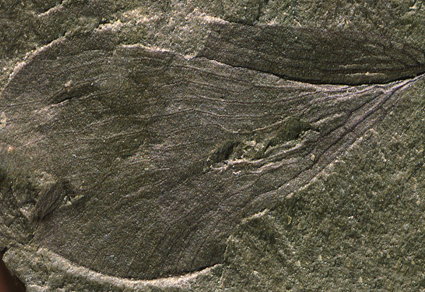Abstract
Thaumatomeropidae is an enigmatic mecopteran family previously known exclusively from the Triassic Madygen entomofauna of Kyrgyzstan. Thaumatomeropids display mosaic venation, closely resembling those of Meropeidae and Eomeropidae, yet distinguished by some more “primitive” characters. Here we describe and illustrate a new thaumatomeropid species, Thaumatomerope sinensis Lian & Huang, sp. nov., from the late Middle Triassic Tongchuan entomofauna of the Chang 7 Member of the Yanchang Formation near the Hejiafang Village, Tongchuan City, NW China. This new species is characterized by reduced Rs branches, and some unique forking patterns, including the single posterior last branch of Rs and multi-branched anterior first branch of M. It represents the first thaumatomeropid species reported outside Kyrgyzstan, indicating a broader geographical distribution of the family. Moreover, this discovery enhances the resemblance of mecopteran components between the Tongchuan and the Madygen entomofaunas.
References
- Cockerell, T.D.A. (1909) Description of Tertiary insects, VI. American Journal of Science, 27, 381–387.
- Friedrich, F., Pohl, H., Beckmann, F. & Beutel, R.G. (2013) The head of Merope tuber (Meropeidae) and the phylogeny of Mecoptera (Hexapoda). Arthropod Structure & Development, 42 (1), 69–88. https://doi.org/10.1016/j.asd.2012.09.006
- Grimaldi, D.A. & Engel, M.S. (2013) The relict scorpionfly family Meropeidae (Mecoptera) in Cretaceous amber. Journal of the Kansas Entomological Society, 86 (3), 253–263. https://doi.org/10.2317/JKES130219.1
- Handlirsch, A. (1906) Die fossilen Insekten und die Phylogenie der rezenten Formen: Ein Handbuch für Paläontologen und Zoologen. Engelmann, Leipzig, 640 pp.
- Hong, Y.C. (2009a) First discovery of fossil Parachoristidae (Insecta: Mecoptera) in China. Geological Bulletin of China, 28 (10), 1382–1289.
- Hong, Y.C. (2009b) Midtriassic new genera and species of Orthophlebiidae and Neorthophlebiidae (Insecta, Mecoptera) from Shaanxi, China. Acta Zootaxonomica Sinica, 34 (3), 423–427.
- Hong, Y.C., Chen, S.E. & Liu, C.T. (2002) Middle Triassic new fossils of Protorthophlebia Tillyard (Insecta: Mecoptera) from Tongchuan region, Shaanxi Province, China. Entomologia Sinica, 9 (2), 51–57. https://doi.org/10.1111/j.1744-7917.2002.tb00470.x
- Lian, X.N., Cai, C.Y. & Huang, D.Y. (2021) New species of Mesopsyche Tillyard, 1917 (Mecoptera: Mesopsychidae) from the Triassic of northwestern China. Zootaxa, 4995 (3), 565–572. https://doi.org/10.11646/zootaxa.4995.3.10
- Lian, X.N., Cai, C.Y. & Huang, D.Y. (2022) New species of permochoristids (Insecta, Mecoptera) from the late Middle Triassic Tongchuan entomofauna in Shaanxi Province, northwestern China. Historical Biology, 35 (11), 2005–2010. https://doi.org/10.1080/08912963.2022.2130794
- Lian, X.N., Cai, C.Y. & Huang, D.Y. (2023) New genera and species of parachoristids (Insecta: Mecoptera) from the Tongchuan entomofauna of Shaanxi Province, northwestern China. Alcheringa: An Australasian Journal of Palaeontology, 47 (1), 109–116. https://doi.org/10.1080/03115518.2023.2168059
- Minet, J., Huang, D.Y., Wu, H. & Nel, A. (2010) Early Mecopterida and the systematic position of the Microptysmatidae (Insecta: Endopterygota). Annales de la Société entomologique de France, New Series, 46 (1–2), 262–270. https://doi.org/10.1080/00379271.2010.10697667
- Novokshonov, V.G. (1997) Early evolution of scorpionflies (Insecta: Panorpida). Nauka, Moscow, 137 pp.
- Novokshonov, V.G. (2002) Order Panorpida Latreille, 1802. In: Rasnitsyn, A.P. & Quicke, D.L.J. (Eds.), History of Insects. Kluwer Academic Press, Dordrecht, pp. 194–198.
- Packard, A.S. (1886) A new arrangement of the orders of insects. The American Naturalist, 20, 808. https://doi.org/10.1086/274333
- Ponomarenko, A.G. & Rasnitsyn, A.P. (1974) New Mesozoic and Cenozoic Protomecoptera. Paleontological Journal, 8, 493–507.
- Ren, D., Labandeira, C.C., Santiago-Blay, J.A., Rasnitsyn, A., Shih, C.K., Bashkuev, A., Logan, M.A.V., Hotton, C.L. & Dilcher, D. (2009) A probable pollination mode before angiosperms: Eurasian, long-proboscid scorpionflies. Science, 326, 840–847. https://doi.org/10.1126/science.1178338
- Shcherbakov, D.E. (2008) Madygen, Triassic Lagerstätte number one, before and after Sharov. Alavesia, 2, 113–124.
- Soszyńska-Maj, A., Krzemiński, W., Kopeć, K. & Coram, R.A. (2016) Phylogenetic relationships within the relict family Eomeropidae (Insecta, Mecoptera) based on the oldest fossil from the Early Jurassic (Sinemurian) of Dorset, southern England. Journal of Systematic Palaeontology, 14 (12), 1025–1031. https://doi.org/10.1080/14772019.2016.1139007
- Willmann, R. (1978) Fossilium Catalogus, Animalia. Mecoptera (Insecta, Holometabola). Vol. 124. Dr. W. Junk bv Publishers, Hague, 139 pp.
- Willmann, R. (1981) Phylogenie und Verbreitungsgeschichte der Eomeropidae (Insecta: Mecoptera). Ein Beispiel für die Anwendung der phylogenetischen Systematik in der Palaeontologie. Palaeontologische Zeitschrift, 55, 31–49. https://doi.org/10.1007/BF02986036
- Willmann, R. (1989) Evolution und phylogenetisches system der Mecoptera (Insecta: Holometabola). Abhandlungen der Senckenbergischen Naturforschenden Gesellschaft, 544, 1–153.


